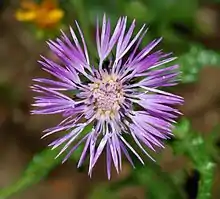Galactites tomentosus
Galactites tomentosus, the purple milk thistle, is a biennial herbaceous plant belonging to the genus Galactites of the Asteraceae family.[2]
| Galactites tomentosus | |
|---|---|
 | |
| Scientific classification | |
| Kingdom: | Plantae |
| Clade: | Tracheophytes |
| Clade: | Angiosperms |
| Clade: | Eudicots |
| Clade: | Asterids |
| Order: | Asterales |
| Family: | Asteraceae |
| Genus: | Galactites |
| Species: | G. tomentosus |
| Binomial name | |
| Galactites tomentosus Moench[1] | |
| Synonyms | |
Description
Galactites tomentosus is a hemicryptophyte plant up to 1 metre (3 ft 3 in) tall. The stem is erect and pubescent, branched at the top. The leaves are green, long and pinnatisect, lanceolate, mottled with white markings, while the underside is whitish and covered with matted woolly hairs. The margins of the leaves bear strong thorns.[2]
The flower heads are quite large – about 3 centimetres (1.2 in) in diameter. The involucre of the flower head is covered by hairy scales ending with a single grooved thorn. The central flowers are hermaphrodite and are pollinated by insects, while external flowers are sterile; their color varies from white or pink to lilac-purple.[2]
The flowering period extends from April through July[2] and the seeds ripen from August through September. The fruits are achenes with whitish hairy appendages (pappus).[2]
Etymology
The genus name derives from the Greek γάλα (= "milk"), referring to the dense white hairs covering the stems and leaves of this species, the species name tomentosus means hairy in Latin.[2]
Distribution
This plant is distributed around the Mediterranean Basin, from Greece to the Iberian Peninsula, Morocco and Madeira and Canary Islands.[3] It has been introduced to the Azores.[4]
Habitat
This plant prefers sunny places and usually grows on the uncultivated or barren grounds, waste places, well-drained soils, pastures and roadsides.[3]
Gallery
 Flowerhead of Galactites tomentosus
Flowerhead of Galactites tomentosus Bud of Galactites tomentosus
Bud of Galactites tomentosus Flowerheads of Galactites tomentosus
Flowerheads of Galactites tomentosus Leaf of Galactites tomentosus
Leaf of Galactites tomentosus Plant of Galactites tomentosus
Plant of Galactites tomentosus
References
- Moench, Conrad (1794). Methodus Plantas Horti Botanici et Agri Marburgensis : a staminum situ describendi (in Latin). p. 558.
- Longo, Daniela (2008). "Galactites tomentosus Moench - Scarlina". Acta Plantarum (in Italian). Retrieved 11 February 2015.
- Pignatti, Sandro (1982). Flora d'Italia (in Italian). Vol. 3. p. 164.
- "Galactites tomentosus" (PDF). Flora Iberica. Retrieved 28 October 2022.
- "Galactites tomentosus Moench". Tropicos. Missouri Botanical Garden. Retrieved 11 February 2016.
External links
 Media related to Galactites tomentosa at Wikimedia Commons
Media related to Galactites tomentosa at Wikimedia Commons